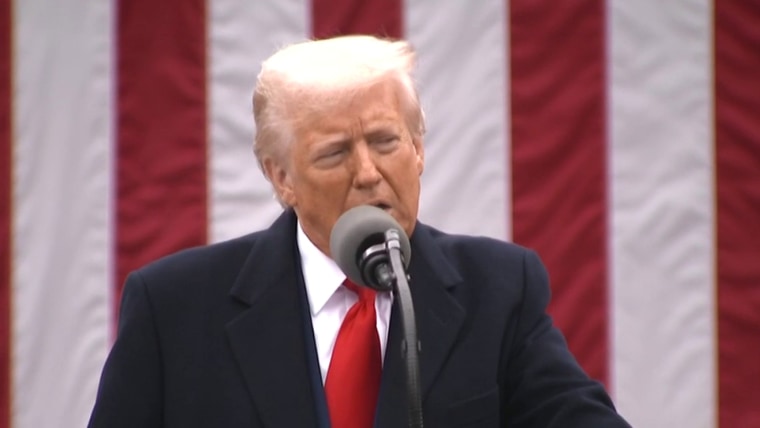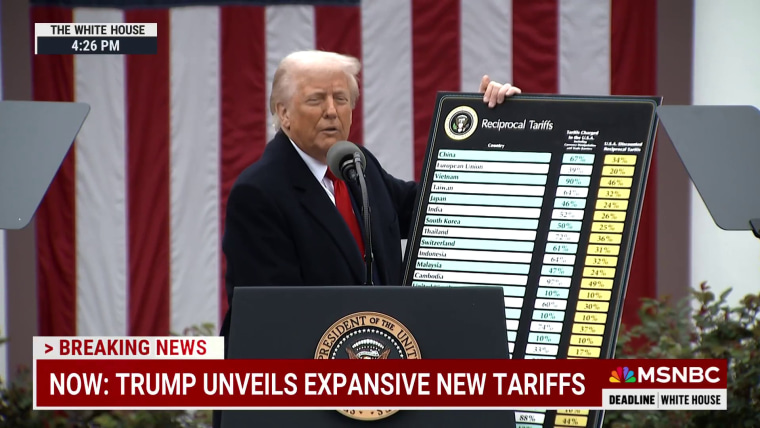President Donald Trump’s describing his new tariff announcement as “Liberation Day” is perhaps an apt description of his “liberating” families from their wallets.
After all, Trump inherited a growing (if imperfect) economy that just 10 weeks later is facing collapsing consumer confidence, paralyzed business investment, rising prices, deepening job losses and a cratering stock market. Business cycles will inevitably bring occasional downturns, but this economic decline has the rare attribute of being entirely self-inflicted by the current president.
The president inexplicably claims that tariffs will somehow cut off imports while also raising trillions of dollars from taxing these imports that no longer exist.
The president’s minimum global tariff rate of 10% and country-specific rates as high as 50% are nearly impossible to justify. They are not designed to retaliate against unfair trading practices. The European Union, whose 1.3% average tariff rate is slightly below America’s pre-2025 rate of 1.5%, would be hit with a 20% tariff. Japan’s 1.6% average tariff rates would be answered with America’s 24% tariff. Canada and Mexico, which have followed U.S.-led trade deals, are nonetheless expected to be soon transitioned to these full rates, too. Tariffs on China would reach 54% when combined with earlier policies.
Nor are the White House tariff rates based on relationships with the U.S. The tariff rates on the European Union (20%), Japan (24%) and Israel (17%) are more punitive than the tariff on Iran (10%). Russia — from whom America still purchases some imports — is also protected from above-minimum tariffs. There is no coherent strategy behind these country-by-country tariff rates.
Trump continues to justify these tariffs as bringing back what he characterizes as the wealthy utopia created by the 1890 McKinley tariff. His economic team may wish to inform him that the 1890 tariffs were followed by a severe 1893 depression that saw the economy collapse by 10% and the unemployment rate hit 18%. And while the president bizarrely blamed the 1930s Great Depression on the 1913 move toward income taxes over tariffs to fund Washington, it was actually the 1930 Smoot-Hawley tariff law that accelerated the Great Depression.

Yet Trump has imposed not only the highest tariff rates in the industrialized world, but also the largest American tariff since the 1800s — even steeper than those that helped bring the Great Depression.
These painful trade restrictions are supposedly a response to trade deficits that the president does not seem to understand and whose tariffs will not fix.
Referring to America’s trade deficit with our northern neighbor, he says, “We’re spending $200 billion a year to subsidize Canada.” Not only is the actual gap $64 billion, but a trade deficit is not a subsidy. It merely means that Americans purchased $64 billion more of Canadian goods than Canadians purchased of our goods. Canada then takes those extra $64 billion and invests them back in the United States, such as buying Treasury bonds that keep interest rates low. In other words, the flip side of a trade deficit is a capital account surplus, as the balance of international payments nets to zero.
These painful trade restrictions are supposedly a response to trade deficits that the president does not seem to understand and whose tariffs will not fix.
America runs trade deficits because it has a strong economy powered by consumer spending and because its low savings rate encourages international investors to spend those excess American dollars funding America’s investment demands. Tariffs will not notably shrink this trade deficit, as the decline in imports will be roughly matched by a decline in exports as the dollar becomes more expensive. Instead, any falling trade deficit would likely result from a Trump-induced recession’s slowing consumer demand.
Nor will tariffs rescue the manufacturing sector, in which long-term job losses have been driven more by automation than by foreign competition. Perhaps America can modestly increase manufacturing employment by onshoring foreign manufacturing, but these jobs will surely have lower wages and tougher working conditions than the jobs they replace in export heavy industries like technology and software development.
Is it progress to force Americans to pay $90 for an American toaster (rather than $30 for an imported toaster) while killing millions of export industry jobs in the process? The beauty of trade is allowing America to focus on creating higher-paying jobs with easier working conditions, while its trading partners without our economic resources prioritize jobs in less worker-friendly, lower-paying industries.
Moreover, U.S. manufacturing — including the auto industry — is a lead importer of inputs such as auto parts. Which is why the U.S. manufacturing sector has fallen into a decline with Trump’s tariffs announcement, and even U.S. automakers are bracing for heavy losses. When the very manufacturing sector these tariffs are supposed to help is also suffering from them, then who exactly are the winners in this painful scheme?

The president inexplicably claims that tariffs will somehow cut off imports while also raising trillions of dollars from taxing these imports that no longer exist. The reality is that tariffs are a tax on American importers, and — like any business tax — much of the cost will be passed on to consumers.
When the Trump administration imposed a tariff on washing machines in 2018, prices immediately jumped by 9% until the tariff expired in 2023, at which point those prices dropped back by 9%. Trump has stated he “couldn’t care less” if import prices rise even as he imposes tariffs on cars, food, prescription drugs and low-cost consumer goods on which lower earners rely. Tariffs even cause domestic companies to raise prices because many use inputs produced abroad and because even U.S.-based companies will have an easier time raising prices without foreign competition.
Overall, the Yale Budget lab estimates that similar tariff rates would cost the median-earning family nearly $4,000 if other nations retaliate.
Nor will the promised tax revenue surge materialize. A tariff tax base of $3.2 trillion means that an average tariff rate of 20% could theoretically raise $640 billion annually in import taxes. However, actual revenues will be drastically reduced by falling demand for tariffed items, as well as a broader reduction in tax revenues due to slower economic growth. From there, any remaining revenues will likely be spent bailing out farmers and other victims of the retaliatory tariffs on American exports — which is exactly what happened with Trump’s first-term tariff revenues. Ultimately, any deficit reduction will be marginal and not remotely worth the significant economic damage.
Unfortunately, new generations often learn only by repeating the mistakes of earlier ones. The generation that suffered under the Smoot-Hawley tariffs and the Great Depression is almost entirely gone, leaving new history-challenged voters to be seduced by overly simplistic calls to “stop exporting jobs abroad” and “produce everything we need right here in America.” The sliver of encouraging news is that today’s voters are finally learning from its own experience, as a new Gallup Poll shows that support for international trade — which was 40% in 2007 and 61% last year — has leaped to 81% this year. And that is before the latest painful tariffs are implemented.
As C.S. Lewis once said, “Experience: that most brutal of teachers. But you learn, my God do you learn.”
